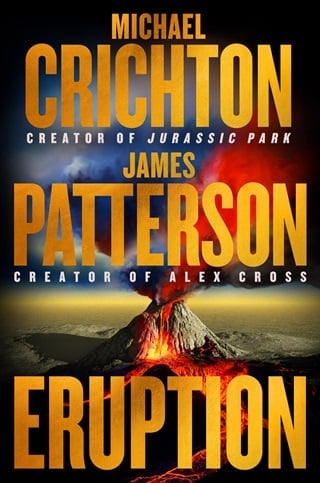Chapter 25
NOAA Mauna Loa Observatory, Hawai‘i
Ahalf hour before the morning meeting, everyone from HVO had been packed into the belly of one Chinook copter. Now they were all clustered around Kenny Wong's laptop. Alongside it was the laptop belonging to one of the six young guys from the military base. The six guys immediately began swinging away at Kenny and Rick's calculations.
They were doing it politely, but that didn't matter. They were relentlessly carving up his work into what he imagined were bite-size morsels. It made Kenny want to hide under his desk. Rick Ozaki was sitting next to him breathing heavily and painfully, like a wounded bear. Kenny didn't dare look around for Mac.
It turned out these guys were part of a geophysical modeling team from AOC, Army Ordnance Corps.
And, Kenny had to admit, they were damned good.
They had been to UH and reviewed Kenny's stored data. They had run their own calculations on the data. And they seemed to have dozens of additional programs that they were running and rerunning on the spot.
Finally, the head of the team, a George Clooney look-alike named Morton, said, "I think we need to go outside now. All of us."
Kenny, Rick, Mac, Jenny, Briggs, and the army guys all walked outside, shoes crunching on black lava. It was sunny up there at eleven thousand feet, with a light, fluffy cloud layer about five thousand feet below them.
"I'm sorry, boys," Morton said, "but the stress-load calculations are very clear. Even if you have magma within a kilometer of the surface—and most of it is much deeper than that—there is no way to open a one-kilometer vent in a mountain with conventional explosives. This mountain is too big; the forces are too big. It would be like trying to move a jumbo jet with a swizzle stick."
Kenny said, "Even with resonant explosives?" Resonant explosives were a recent innovation. The idea was to use small, precisely timed charges to set up resonant movement in large objects, the way giving small pushes to a swing gradually made it go higher and higher.
"Even resonant explosives won't do it," Morton said. "Computer-controlled timing can produce very powerful effects. But we're still orders of magnitude too small. Even if we wanted to go nuclear—and I'm going to assume we don't—it probably wouldn't be enough."
No one spoke right away. The only sound was the wind.
During the discussion, something had nagged at Mac. He gazed at the summit now, shielding his eyes against the glare of the sun, looking past the engineers and Colonel Briggs and Jenny and the guys from the data room to where steam vents hissed into the air.
He had been thinking about steam all day.
Whenever the volcano began degassing, there was always the question of whether it was gas released by magma or groundwater being heated to steam. Steam eruptions had occurred on multiple occasions in the past, and Mac knew the dangers they presented, and not just to the environment.
"Hold on a minute," he said.
They all turned to him.
"We're thinking about this wrong," Mac said.
Morton, who was standing next to Briggs, said, "How so?"
"We're thinking about ways to control the volcano," Mac said. "But we can't."
"Right," Morton said. "We don't have the explosive power to open a vent, and we can't generate enough energy to do it."
"But the volcano itself has plenty of energy," Mac said.
He felt them all staring at him.
"What if we can make the volcano do the work for us?" Mac asked.
Briggs said, "Wait… what?"
Mac said, "How far down can you place explosives?"
"That depends on the thickness of the basalt and the presence of thermal effects," Morton said. "But that doesn't alter the basic—"
Mac ignored him and addressed Briggs. "Those helicopters you have carrying the bulldozers—"
"Chinooks," Briggs said.
"Can they also carry water?"
Rick Ozaki dropped his head. He was sure he knew what his boss would say next. Quietly he murmured, "Please, God, no," to his boots.
Jenny Kimura was shaking her head. "John MacGregor," she said.
It was never good when she used his full name. But she also knew where he was headed with this.
Briggs said, "Yes, they can carry water. They've occasionally been used for firefighting."
"How much water?" Mac said.
"I'd have to check. Water's heavy. But I'm guessing three thousand gallons each."
"How many helicopters can you get?"
"I'd have to check that too. I think we've got five at Barking Sands on Kaua‘i. There's probably fifteen or twenty on all the islands. Why?"
"This summit—this whole mountain—is dotted with lava tubes and air chambers," Mac said. "Most of them are sealed over by the eruption that created them, and some of them are very large. We knew they were there, but we didn't know exactly where until we started mapping using high-resolution magnetometry. Anyway, you could break into the underground pockets and place your explosives, then you could fill them with water and seal them."
"Which would do what, exactly?" one of the army engineers finally asked.
"Keep the detonation wave under high pressure. Restore the explosive capacity. Instead of moving magma up, you'd just have to move water down to contact the magma."
"Where it makes steam and hisses out for a few hours," the engineer said.
"Only if the contact is slow. But if you make a sudden contact…" Mac said.
"I hear you!" another one of the AOC men said. He turned to the others on his team. "You could use quad arrays in multiples."
"We'd need a lot of on-site calculations…"
"I know," the AOC man said, "but I believe it is possible."
"And how would you get the arrays to communicate?" another man asked Mac.
"You don't," Mac said. "You make them autonomous."
The AOC team huddled together. Mac could hear them talking excitedly, although they kept their voices low. One of them picked up a chunk of lava. Someone said something about porosity and sealant pressures.
Rick and Kenny walked over to Mac; Mac could see the concern on Rick's face.
"Mac," Rick said, "you know what you're saying, right? You're talking about making this volcano explode."
"You know something, though? It just might work," Kenny said.
"And that's exactly what I'm afraid of," Rick said. "We're talking about trying to make a nuée ardente. An avalanche of fire. The most dangerous volcanic phenomenon there is."
"Pretty much," Mac said.
 Fullepub
Fullepub 



